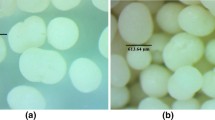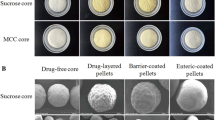Abstract
Modified-release multiple-unit tablets of loratadine and pseudoephedrine hydrochloride with different release profiles were prepared from the immediate-release pellets comprising the above two drugs and prolonged-release pellets containing only pseudoephedrine hydrochloride. The immediate-release pellets containing pseudoephedrine hydrochloride alone or in combination with loratadine were prepared using extrusion–spheronization method. The pellets of pseudoephedrine hydrochloride were coated to prolong the drug release up to 12 h. Both immediate- and prolonged-release pellets were filled into hard gelatin capsule and also compressed into tablets using inert tabletting granules of microcrystalline cellulose Ceolus KG-801. The in vitro drug dissolution study conducted using high-performance liquid chromatography method showed that both multiple-unit capsules and multiple-unit tablets released loratadine completely within a time period of 2 h, whereas the immediate-release portion of pseudoephedrine hydrochloride was liberated completely within the first 10 min of dissolution study. On the other hand, the release of pseudoephedrine hydrochloride from the prolonged release coated pellets was prolonged up to 12 hr and followed zero-order release kinetic. The drug dissolution profiles of multiple-unit tablets and multiple-unit capsules were found to be closely similar, indicating that the integrity of pellets remained unaffected during the compression process. Moreover, the friability, hardness, and disintegration time of multiple-unit tablets were found to be within BP specifications. In conclusion, modified-release pellet-based tablet system for the delivery of loratadine and pseudoephedrine hydrochloride was successfully developed and evaluated.




Similar content being viewed by others
References
Bodmeier R. Tableting of coated pellets. Eur J Pharm Biopharm. 1997;43:1–8.
Bechgaard H, Neilson GH. Controlled release multiple units and single-unit doses. Drug Dev Ind Pharm. 1978;4:53–67.
Bechgaard H. Critical factors influencing gastrointestinal absorption—what is the role of pellets? Acta Pharm Technol. 1982;28(2):149–57.
Wilson CG, Washington C, Washington N. Overview of epithelial barriers and drug transport. In: Wilson CG, Washington N, editors. Physiological pharmaceutics: biological barriers to drug absorption. Chichester: Ellis Horwood Limited; 1989. p. 60–70.
Beckett AH. Proceedings of an International Symposium on Recent Advances in the Design, Development and Assessment of Sustained Release Drug Delivery Systems.1985; Liverpool.
Wieslaw S, Rafal L. Compressibility of floating pellets with verapamil hydrochloride coated with dispersion Koollicoat SR 30 D. Eur J Pharm Biopharm. 2005;60:153–58.
Tunon A, Borjesson E, Frenning G, Alderborn G. Drug release from reservoir pellets compacted with some excipients of different physical properties. Eur J Pharm Biopharm. 2003;20:469–79.
Dashevsky A, Kolter K, Bodmeier R. Compression of pellets coated with various aqueous polymer dispersions. Eur J Pharm Sci. 2004;279:19–26.
Zeeshan F, Peh KK, Tan YTF. Exploring the potential of a highly compressible microcrystalline cellulose as novel tabletting excipient in the compaction of extended-release coated pellets containing an extremely water-soluble model drug. AAPS PharmSciTech. 2009;10(3):850–57.
Connell JT. A novel method to assess antihistamine and decongestant efficacy. Ann Allergy. 1979;42:278–85.
Falliers CJ, Redding MA. Controlled comparison of a new antihistamine–decongestant combination to its individual components. Ann Allergy. 1980;45:75–80.
Connell JT, Williams BO, Allen S, Cato A, Perkins JG. A double- blind controlled evaluation of Actifed and its individual constituents in allergic rhinitis. J Int Med Res. 1982;10:341–47.
Sznitowska M, Cal K, Kupiec K. Development of modified-release dosage forms containing loratadine and pseudoephedrine sulphate. Acta Pol Pharm. 2004;61:72–4.
Schaefer T, Worts O. Control of fluidized bed granulation: effects of spray angle, nozzle height and starting materials on granule size and size distribution. Arch Pharm Chem Sci. 1977;5:51–60.
Tan YTF, Heng PWS, Wan LSC. Mixed polymer coating for modified release from coated spheroids. Pharm Dev Technol. 1999;5(4):561–70.
British Pharmacopoeia. Vol IV. London, UK: British Pharmacopoeia Commission Office; 2008: Appendix XII C A303-5.
British Pharmacopoeia. Vol IV. London, UK: British Pharmacopoeia Commission Office; 2008: Appendix XVII H A423-4.
British Pharmacopoeia. Vol IV. London, UK: British Pharmacopoeia Commission Office; 2008: Appendix XII A A283-4.
Laakso L, Kristoffersson E, Marvola M. Bi-exponential first-order release kinetics of indomethacin from tablets containing polysorbate 80. Eur J Pharm Sci. 1984;19:35–42.
Lippold BC, Monells Pagés R. Control and stability of drug release from diffusion pellets coated with the aqueous quaternary polymethacrylate dispersion Eudragit RS 30 D. Pharmazie. 2001;56(6):477–83.
Nisar ur Rahman, Yuen KH, Khan NA, Wong JW. Drug–polymer mixed coating: a new approach for controlling drug release rates in pellets. Pharm Dev Technol. 2006;11(1):71–7.
Chen S, Zhu J, Cheng J. Preparation and in vitro evaluation of a novel combined multiparticulate delayed-onset sustained-release formulation of diltiazem hydrochloride. Pharmazie. 2007;62(12):907–13.
Huang HF, Lu Y, He HB, Tang X. Preparation and bioavailability of sustained-release doxofylline pellets in beagle dogs. Drug Dev Ind Pharm. 2008;34(7):676–82.
Ghaffari A, Avadi MR, Moghimi HR, Oskoui M, Bayati K, Rafiee-Tehrani M. Mechanistic analysis of drug release from theophylline pellets coated by films containing pectin, chitosan and Eudragit RS. Drug Dev Ind Pharm. 2008;34(4):390–02.
Mikatos A, Panderi I. Determination of the carboxylic acid metabolite of clopidogrel in human plasma by liquid chromatography–electrospray ionisation mass spectrometry. Analytica Chim Acta. 2004;505:107–14.
Zahirul M, Khan I, Dragica Raušl, et al. Classification of loratadine based on the biopharmaceutics drug classification concept and possible in vitro–in vivo correlation. Biol Pharm Bull. 2004;27:1630–35.
Flament MP, Leterme P, Gayot A, Gendrot E, Bruna E, Cousin G. Development and industrial scale-up of tablets containing modified-release pellets. Pharm Technol Eur. 1994;2:19–25.
Vergote GJ, Kiekens F, Vervaet C, Remon JP. Wax beads as cushioning agents during the compression of coated diltiazem pellets. Eur J Pharm Sci. 2002;17:145–51.
Celik M. Compaction of multiparticulate oral dosage forms. In: Ghebre-Sellasie, editor. Multiparticulate oral drug delivery. New York: Marcel Dekker; 1994. p. 181–15.
Declaration of interest
The authors report no declaration of interest.
Author information
Authors and Affiliations
Corresponding author
Rights and permissions
About this article
Cite this article
Zeeshan, F., Bukhari, N.I. Development and Evaluation of a Novel Modified-Release Pellet-Based Tablet System for the Delivery of Loratadine and Pseudoephedrine Hydrochloride as Model Drugs. AAPS PharmSciTech 11, 910–916 (2010). https://doi.org/10.1208/s12249-010-9456-2
Received:
Accepted:
Published:
Issue Date:
DOI: https://doi.org/10.1208/s12249-010-9456-2




